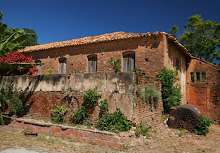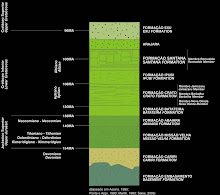
The Parque Cultural del MAESTRAZGO, covers an area of 270,000 ha and lies between Zaragoza and Teruel in the catchment of the Guadalope river. The area belongs to the Cordillera, a dry mountain land characterised by hot summers and cold winters and with deeply incised yellow-brown valleys. The area lies in the former kingdom of Acagon and in the Middle Ages it was named "Maestrazgo"by the "maestres", a military order which administered this region.
There are six centres within the Park: the Geological Park in Aliaga, the History Museum in Mas de als Matas, the Cultural Park of Molinos, the Centre for Science of Environment in Villarluen-go, the Palaeontological Park in Galve and finally the Sculpture Park in Hino-josa de Jarque.
The little village of Aliaga, 50km northeast of the town of Teruel, is interesting because it lies at the nodal point of two geological folds that followed one another. In the Mesozoic, 220 - 65 million years ago, an embayment of a warm sea periodically covered this area. During these times the bottom of the sea was colonized by corals and other invertebrate animals. At other times, the sea retreated and rivers deposited sediment here. 65 million years ago during the formation and folding of the Pyrenees a geological saddle, or anticline, orientated approximately north-south, was formed. Subsequently a geological depression, or syncline, running nearly towards east-west was created. After that the Guadalope River and its tributaries cut deep into these structures.
The little village of Aliaga, 50km northeast of the town of Teruel, is interesting because it lies at the nodal point of two geological folds that followed one another. In the Mesozoic, 220 - 65 million years ago, an embayment of a warm sea periodically covered this area. During these times the bottom of the sea was colonized by corals and other invertebrate animals. At other times, the sea retreated and rivers deposited sediment here. 65 million years ago during the formation and folding of the Pyrenees a geological saddle, or anticline, orientated approximately north-south, was formed. Subsequently a geological depression, or syncline, running nearly towards east-west was created. After that the Guadalope River and its tributaries cut deep into these structures.
Harder rocks like limestone, dolomite educational path with eleven special points, where ceramic boards with drawings and text explain the facts to interested amateurs, pupils, students or scientists. In the Palaeontological Park of Galve, fossils and printings of dinosaurs, as well as life-sized replicas, can be examined at in awe. As a result of these projects the Geological and Paleontological Park are now known all over the world including specialists and scientists who regularly visit that region.
European Geoparks Informations http://europeangeoparks.org/





Nenhum comentário:
Postar um comentário